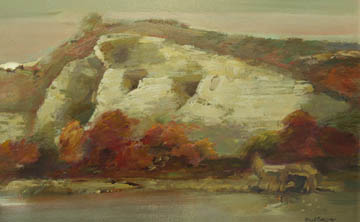
Formed under President Franklin D. Roosevelt’s New Deal Program in 1935, the Works Progress Administration (WPA) was developed to create jobs for the then record number of unemployed Americans suffering through the Great Depression. The concept of the WPA was to employ men and women on useful projects rather than just subsidizing their existence. The WPA was highly diversified, providing jobs for builders, plumbers, electricians, writers and artists. The Federal Art Project (FAP), a branch of the WPA, along with the Federal Writers’ Project and the Federal Theatre Project provided thousands of jobs for artists, writers and actors.
The FAP had several divisions. The murals division produced more than 2,500 works located in post offices, hospitals, schools and other public places. The easel painting division produced almost 108,000 paintings and the sculpture division produced approximately 18,000 pieces. While these projects allowed some artistic freedom, much of the art that was produced under the FAP was either regionalist (depicting local histories) or had some sort of nationalist subject. Many of the paintings and sculptures were loaned out to libraries and schools.
The FAP was also involved in photography, graphic arts and set design, and it organized exhibitions of works by WPA artists. Education was a major focus of the FAP, as seen in projects that involved the formation of community art centers and in research projects like the Index of American Design in which 20,000 photographic plates were produced documenting the daily life of the American people through design such as textiles, glass, ceramics and copper. The FAP also hired photographers to document American cities, and similar WPA writing projects, such as the American Guide Series, created written histories of various parts of the nation.
There are still a number of FAP works visible in Missouri. The Higginsville Post Office has an FAP mural painted by Jac T. Bowen in 1942 that depicts the history and businesses that thrived in that town. The mural, “Back Home: April 1865” by Tom Lea is located in the Pleasant Hill, Missouri post office. In St. Louis there are numerous murals including the “Louisiana Purchase Exposition” by Trew Hocker in the University City Post Office, the “Old Levee and Market at St. Louis” by Lumen Martin Winter at the Wellston Public School and two cycles on the history of the region at the St. Louis Post Office by Edward Millman and Mitchell Siporin. Examples of FAP sculpture in St. Louis are “Courage, Vision, Sacrifice, Loyalty” by Walker Hancock located in Memorial Plaza (Market and 13th Street) and “Law and Order” and “Equal Justice” by Benjamin Hawkins in the Customs House on Tucker and Market streets.
Many artists who have since become famous were part of FAP such as Philip
Guston, Moses Soyer, Jackson Pollock, Mark Rothko, Jacob Laurence, Ivan
Albright, Marsden Hartley, Philip Evergood and Mark Tobey. The FAP provided
a living for these artists and opportunities for those who would have
had the greatest difficulties sustaining their work otherwise. These projects
made possible work that was acknowledged as important but that the depressed
economy could not otherwise support. World War II put an end to all federally-subsidized
artwork except that related directly to the war effort. The WPA was formally
ended by a presidential proclamation in 1942.